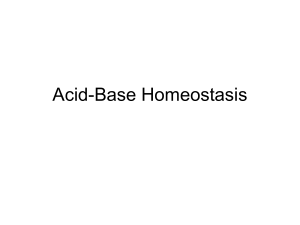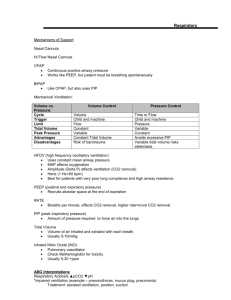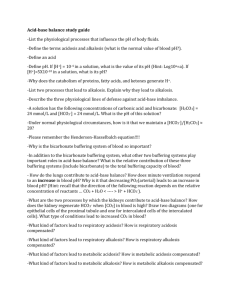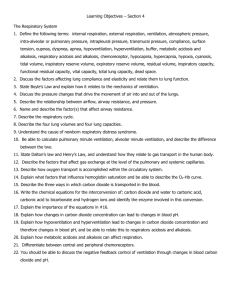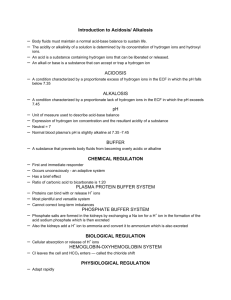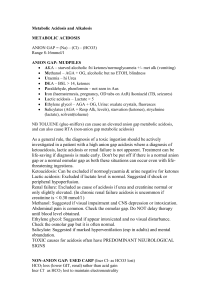ABG problems for students
advertisement
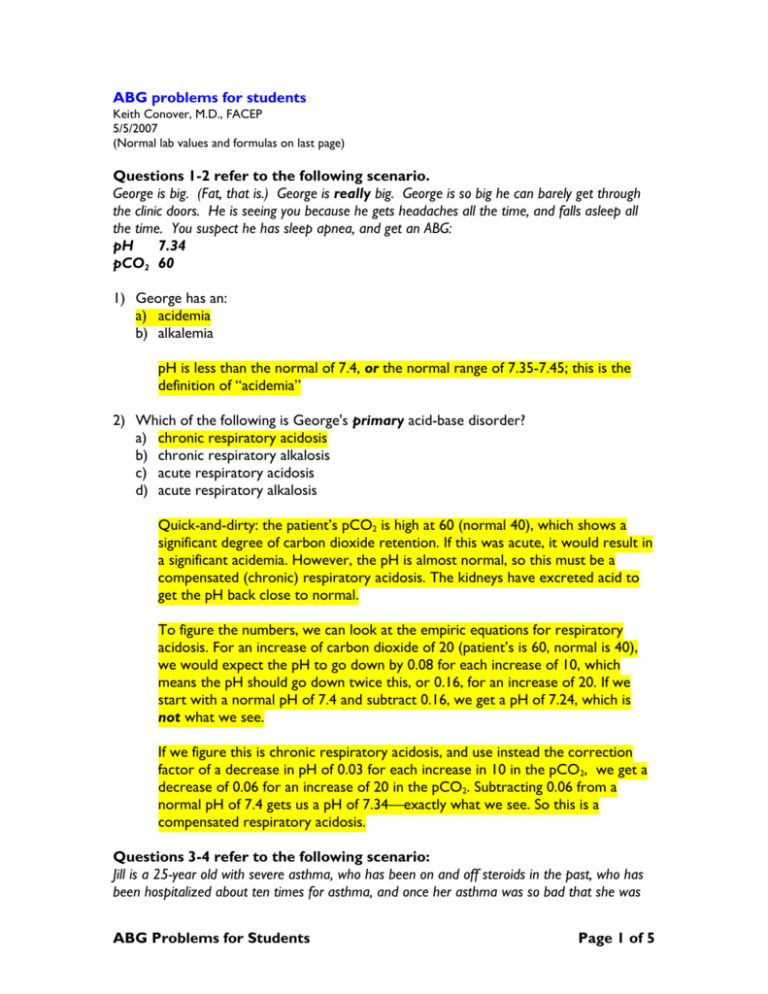
ABG problems for students Keith Conover, M.D., FACEP 5/5/2007 (Normal lab values and formulas on last page) Questions 1-2 refer to the following scenario. George is big. (Fat, that is.) George is really big. George is so big he can barely get through the clinic doors. He is seeing you because he gets headaches all the time, and falls asleep all the time. You suspect he has sleep apnea, and get an ABG: pH 7.34 pCO2 60 1) George has an: a) acidemia b) alkalemia pH is less than the normal of 7.4, or the normal range of 7.35-7.45; this is the definition of “acidemia” 2) Which of the following is George's primary acid-base disorder? a) chronic respiratory acidosis b) chronic respiratory alkalosis c) acute respiratory acidosis d) acute respiratory alkalosis Quick-and-dirty: the patient’s pCO2 is high at 60 (normal 40), which shows a significant degree of carbon dioxide retention. If this was acute, it would result in a significant acidemia. However, the pH is almost normal, so this must be a compensated (chronic) respiratory acidosis. The kidneys have excreted acid to get the pH back close to normal. To figure the numbers, we can look at the empiric equations for respiratory acidosis. For an increase of carbon dioxide of 20 (patient’s is 60, normal is 40), we would expect the pH to go down by 0.08 for each increase of 10, which means the pH should go down twice this, or 0.16, for an increase of 20. If we start with a normal pH of 7.4 and subtract 0.16, we get a pH of 7.24, which is not what we see. If we figure this is chronic respiratory acidosis, and use instead the correction factor of a decrease in pH of 0.03 for each increase in 10 in the pCO2, we get a decrease of 0.06 for an increase of 20 in the pCO2. Subtracting 0.06 from a normal pH of 7.4 gets us a pH of 7.34—exactly what we see. So this is a compensated respiratory acidosis. Questions 3-4 refer to the following scenario: Jill is a 25-year old with severe asthma, who has been on and off steroids in the past, who has been hospitalized about ten times for asthma, and once her asthma was so bad that she was ABG Problems for Students Page 1 of 5 intubated. She comes into the Emergency Department acutely short of breath, breathing at a rate of 40, and can only speak a few words without stopping to catch her breath. Her lips are slightly blue, and you can see retractions above the clavicle with each breath. Her lab tests show: pH: 7.24 pCO2 60 3) Jill's primary acid-base disorder is: a) metabolic acidosis b) metabolic alkalosis c) respiratory acidosis d) respiratory alkalosis As with George, above, Jill has an acidemia—her pH is lower than the normal of 7.4. Her pCO2 is 60—20 above normal—just like George. 4) Has Jill had this acid-base disorder long enough to develop compensation? a) yes b) no Her pCO2 is a lot lower, suggesting this is an acute respiratory acidosis. Indeed, if you remember the calculations for George, we first tried to figure out if he had an acute respiratory acidosis—and came out with a pH of 7.24, exactly what Jill has. So she’s got an acute respiratory acidosis. It’s come on quickly, so her kidneys haven’t had time to excrete acid to bring her pH back to near normal. Questions 5-9 refer to the following scenario. For the past few days, Jack has had "the flu" with URI symptoms and decreased appetite. He's a type I diabetic on a dose of 45 units of 70/30 (NPH/Regular mix) insulin each morning and 40 units each evening. He's generally good at controlling his blood sugar, and usually checks it regularly. He's been cutting his insulin down the past few days because he hasn't been eating much. His brother visited him today, and found him in bed, feverish, "breathing hard" and confused. When you see him in the Emergency Department, you find the following lab values: pH 7.30 pCO2 30 [HCO3] 15 “bicarb”, “CO2” on the lab chemistry report Na- + 140 Cl 100 5) Jack has an: a) acidemia. b) alkalemia. 6) Which of the following is Jack's primary acid-base disorder? a) metabolic acidosis b) metabolic alkalosis c) respiratory acidosis ABG Problems for Students Page 2 of 5 d) respiratory alkalosis This is an acidemia with a low [HCO3], which by definition is a metabolic acidosis. 7) Does Jack show appropriate compensation for this disorder? a) yes b) no To check compensation for a metabolic acidosis, easiest is to use the formula: pCO2 = last 2 digits of the pH = [HCO3-] + 15 and if we use this, we would expect to find 30 = 30 = 30 which checks out just fine for metabolic compensation with expected respiratory compensation, exactly. Winter’s Equation (Winter’s Formula) is also available, which is pCO2 = 1.5([HCO3 ]) + 8 ± 2 = last 2 digits of pH and plugging in the numbers, we get 30 = 22.5+8 = 30 which is pretty good agreement. So, yes, this metabolic acidosis is appropriately compensated. 8) Jack's anion gap is: a) 40 b) 25 c) 12 d) 0 From the standard formula, anion gap = [Na+] - ([Cl-] + [HCO3-]), we plug in Jack’s numbers and get 140 – (100 + 15) which is 25. Is this higher than normal? Yes, the normal is 12 ± 2, and Jack’s anion gap is 13 points higher than normal. 9) Jack's primary acid-base disorder is most likely due to: a) vomiting and loss of gastric acid. b) diabetic ketoacidosis. c) hyperventilation to compensate from the hypoxia of a pneumonia. d) poor ventilation due to a pneumonia. Jack has a fairly severe metabolic acidosis—in fact, a quick glance at the pH and [HCO3-] reveals this. The quick calculation in the previous question shows this is an anion-gap metabolic acidosis. Given the history—and even before the urine ketone test comes back positive—it’s pretty obvious to anyone who’s ever seen it that Jack is in DKA: diabetic ketoacidosis. In fact, he’s pretty sick. Vomiting would cause a metabolic alkalosis. Hyperventilation would cause a respiratory alkalosis. Poor ventilation would cause a respiratory acidosis. 10) Jim is brought into the Emergency Department after a car wreck on a January night. He has no obvious injury except for some minor scrapes, but it took the paramedics about half an hour to extricate him, and he's hypothermic: core temperature 89 ABG Problems for Students Page 3 of 5 degrees F. He's on O2: a nonrebreather face mask. As part of routine trauma labs, you get what looks like a normal ABG to you: 7.40/pO2 220/pCO2 40. The lab calls you because they heard the patient is hypothermic, and would like to give you a corrected ABG report. You: a) Thank them for the corrected report, discard the previous report, and treat the patient according to the newly-discovered acid-base disorder. b) Thank them for the corrected report, note it in the chart, and even though the numbers look abnormal, relax because the patient's acid-base status is normal. Jack’s acid-base status is normal. Few if any people know what a normal ABG is for a hypothermic patient (and it is different than the normals for a normothermic patient). So, the rule is to not correct for hypothermia. Look at the uncorrected ABG, and interpret and treat using the normals for a normothermic ABG. Normal pH Normal pCO2 Normal [HCO3-] Normal anion gap () 7.4 40 27 12 ╔═════════════════════════════════════════════════════════════════════════╗ ║ Check the pH on the blood gas to tell whether the patient has an ║ ║ Acidemia (pH) or Alkalemia (pH) or EupHemia (normal pH). ║ ╠═════════════════════════════════════════════════════════════════════════╣ ║ Check the bicarb on the SMA-6 and the pCO2 on the gas. pH with ║ ║ [HCO3-], or pH with [HCO3-], indicates a primary metabolic acidosis ║ ║ or alkalosis; pH with pCO2, or pH with pCO2, indicates a primary ║ ║ respiratory acidosis or alkalosis. ║ ╠═════════════════════════════════════════════════════════════════════════╣ ║ Check for the expected degree of compensation. (Empiric Equations Below)║ ╠═════════════════════════════════════════════════════════════════════════╣ ║ For metabolic acidosis, check to see if it is an anion gap acidosis, a ║ ║ non-anion gap acidosis, or a mixed disorder. If all of the acidosis ║ ║ is due to anion-gap acids, then the increase in the anion gap should ║ ║ be the same as the decrease in the [HCO3-]. E.g., if the A.G. is 20 ║ ║ (normal 12), and the [HCO3-] is 19 (normal 27), then all of the ║ ║ acidosis (all of the [HCO3-]) is due to the A.G. from excess organic ║ ║ acids that form the anion gap. AG = [Na+] - ([Cl-] + [HCO3-]) ║ ╚═════════════════════════════════════════════════════════════════════════╝ ╔══════════════════════════════════════════════════════════════════════╗ ║ For metabolic acidosis, Winters' equation: ║ ║ pH = 1.5 ([HCO3-] + 8) ± 2 ║ ║ for good compensation except: ║ ║ lactic acidosis may have overcompensation due to CNS effects. ║ ╠══════════════════════════════════════════════════════════════════════╣ ║ For metabolic alkalosis or acidosis, with respiratory compensation: ║ ║ pCO2 = last 2 digits of the pH = [HCO3-] + 15 ║ ║ (for [HCO3-] from 8 to 35) ║ ╠══════════════════════════════════════════════════════════════════════╣ ║ For respiratory acidosis, every increase in pCO2 has an expected ║ ║ decrease in pH: ║ ║ pCO2 10 = pH .08 (acute) ║ ║ pCO2 10 = pH .03 (later, with metabolic compensation) ║ ╠══════════════════════════════════════════════════════════════════════╣ ║ For respiratory alkalosis, each decrease in pCO2 has an expected ║ ║ increase in bicarbonate: ║ ║ pCO2 10 = [HCO3-] 2 (acute) ║ ABG Problems for Students Page 4 of 5 ║ pCO2 10 = [HCO3-] 5 (chronic/compensated) ║ ╚══════════════════════════════════════════════════════════════════════╝ ABG Problems for Students Page 5 of 5
